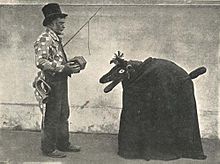
Hoodening (/ʊd.ɛnɪŋ/), also spelled hodening and oodening, is a folk custom found in Kent, a county in South East England. The tradition entails the use of a wooden hobby horse known as a hooden horse that is mounted on a pole and carried by a person hidden under a sackcloth. Originally, the tradition was restricted to the area of East Kent, although in the twentieth century it spread into neighbouring West Kent. It represents a regional variation of a "hooded animal" tradition that appears in various forms throughout Britain and Ireland.
As recorded from the eighteenth to the early twentieth centuries, hoodening was a tradition performed at Christmas time by groups of farm labourers. They would form into teams to accompany the hooden horse on its travels around the local area, and although the makeup of such groups varied, they typically included someone to carry the horse, a leader, a man in female clothing known as a "Mollie", and several musicians. The team would then carry the hooden horse to local houses and shops, where they would expect payment for their appearance. Although this practice is extinct, in the present the hooden horse is incorporated into various Kentish mummers plays and Morris dances that take place at different times of the year.
The origins of the hoodening tradition, and the original derivation of the term hooden, remain subject to academic debate. An early suggestion was that hooden was related to the Anglo-Saxon pre-Christian god Woden (Odin), and that the tradition therefore originated with pre-Christian religious practices in the early medieval Kingdom of Kent. This idea has not found support from historians or folklorists studying the tradition. A more widely accepted explanation among scholars is that the term hooden relates to hooded, a reference to the sackcloth worn by the person carrying the horse. The absence of late medieval references to such practices and the geographic dispersal of the various British hooded animal traditions—among them the Mari Lwyd of south Wales, the Broad of the Cotswolds, and the Old Ball, Old Tup, and Old Horse of northern England—have led to suggestions that they derive from the regionalised popularisation of the sixteenth- and seventeenth-century fashion for hobby horses among the social elite.
The earliest textual reference to the hoodening tradition comes from the first half of the eighteenth century. Scattered references to it appeared over the next century and a half, many of which considered it to be a declining tradition that had died out in many parts of Kent. Aware of this decline, in the early twentieth century the folklorist and historian Percy Maylam documented what survived of the tradition and traced its appearances in historical documents, publishing his findings as The Hooden Horse in 1909. Although deemed extinct at the time of the First World War, the custom was revived in an altered form during the mid-twentieth century, when the use of the hooden horse was incorporated into some modern Kentish folk traditions.